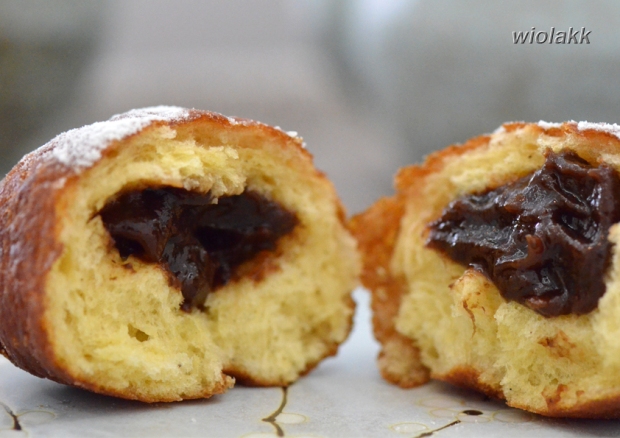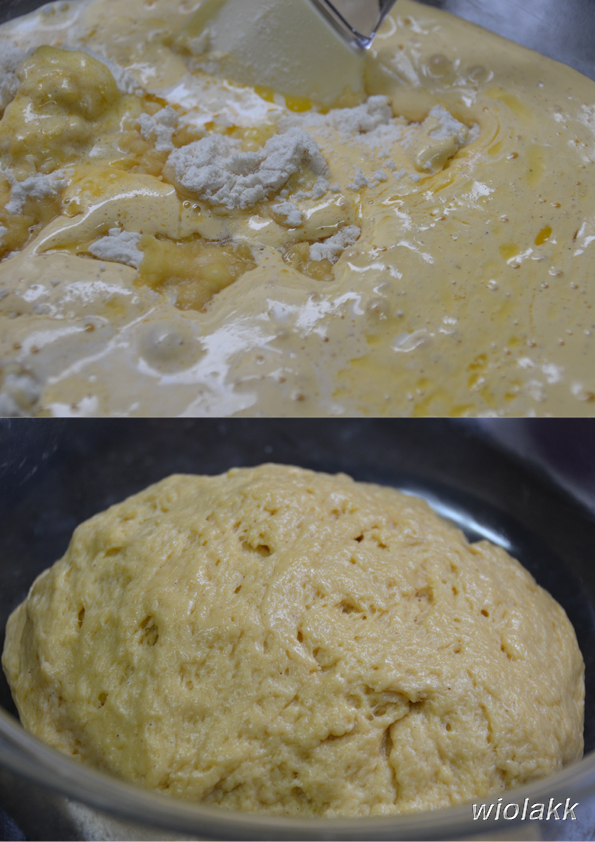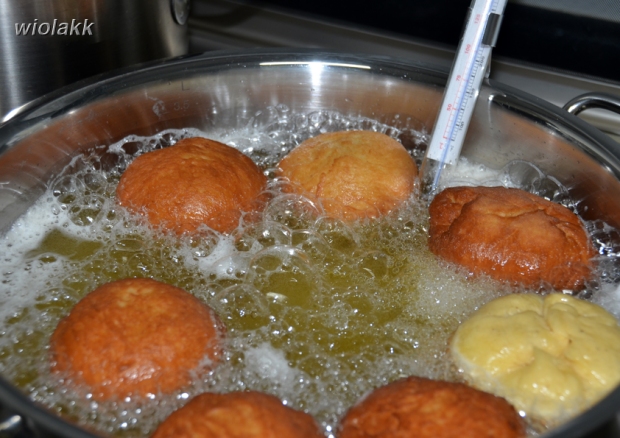Fat, fatter, Fat Thursday – Warsaw Doughnuts (excellent!)
The summer holidays have gone and with it an access to the Internet, computer and my kitchen is finally back after my last almost two months’ absence.
Fat Thursday, the last Thursday before the Ash Wednesday, in Poland is almost synonymous with doughnuts (pączki). On this day, after the Wikipedia in Polish, an average Pole eats 2,5 doughnuts and altogether Poles eat 100 millions doughnuts. You can feel the power of tradition 😉 and you can feel the doughnuts’ smell in the streets coming from the bakeries, patisseries and private households. There is a superstition that if you don’t eat a doughnut on this day, your year won’t be very successful one. Hmm…. Are we so superstitious as a nation? Maybe there is some grain of truth.
In Poland throughout the history the fasts were solemnly kept, taking however every opportunity to feast and celebrate. Until today the main festivals are not free from the sin of overeating. Nowadays the trend of limitation the food can be seen on our tables since our stomachs are not like those in XVII century where scrambled eggs from 10 eggs with bacon and sausages were regarded as a light breakfast, for one person only.
You can find the recipes for pączki (doughnuts) in the XVII century cookery book from the Radziwiłł’s court that was lately revived in the “Monumenta Poloniae Culinaria” series with a very interesting introduction and description by Jarosław Dumanowski (unfortunately only in Polish). Over the centuries the recipes for doughnuts have changed, allowing however the many recipes coexist.
This time I used the recipe from one of my favourite both culinary and history book: “W staropolskiej kuchni i przy polskim stole” by Maria Lemnis and Henryk Vitry (Old Polish traditions in the Kitchen and at the Table). The recipe is not for fainthearted, counting calories, but their taste leaves you in the dark, are you sure you want to get them to share with others?
Pączki warszawskie (znakomite) – Warsaw Doughnuts (excellent)
Ingredients:
Leaven/Biga
60 g fresh yeast
100 g flour
1 Tablespoon sugar
1/3 cup of lukewarm milk
Dough
Leaven
400 g flour + more flour to add while kneading
80 g sugar
8 egg yolks
1 cup lukewarm sweet cream
½ vanilla stick (crushed and sieved) or 1 teaspoon vanilla extract or sugar with real vanilla
150 g lukewarm melted unsalted butter
1/3 teaspoon salt
30 ml of spirit (very strong alcohol, spirit is a 96% alcohol in Poland)
Filling
Plum, strawberry or rose petal jam, not too watery
It can be however any filling you like.
Classical Polish filling is rose petal jam, drained and mixed with ground almonds in a ration 2:1
Ca. 1,5 l of canola oil to fry
Glazing sugar to sprinkle doughnuts
Preparation:
- Around two hours before starting to make doughnuts, bring all ingredients to the room temperature.
- Warm the milk to around 40°C (104 F). Mix all ingredients for the leaven – rub the yeast into the flour and sugar, add the milk, mix. Wait until it will rise accordingly.
- Mix the yolks with sugar for fluffy foam.
- Melt the butter and cool down until lukewarm.
- Warm up the sweet cream until lukewarm. Don’t boil it!
- To the risen yeast add the dough ingredients in order of appearance on the ingredients list.
- Make the dough with your hands in a big bowl until it will start to stand out of the bowl and your hands. It should be not too dense, shiny and elastic. Something like 15-20 minutes should be ok but you need to observe it and if necessary add more flour. I ended up adding something like 1 glass more flour; it always depends on your flour, how dry it is.
- Prepare the place for putting raw doughnuts aside. Spread the linen napkins generously with flour.
- When the dough starts to rise, take a portion of 40 g (it is good to weight the dough to have even sized doughnuts), shape the roundel in your hands, fill around ½ – 1 teaspoon of jam, stick and shape the doughnut ball and put with the joined side down on the flour generously spread linen napkin.
- Cover the form doughnuts with the clean linen napkin and wait until they are almost double the size.
- Heat the oil or lard (I used canola oil, since no lard is available here) in the big, flat pot on the small heating until it will reach ca. 175-180°C (350 F). It can last something like 15 minutes.
- Prepare place for the fried doughnuts. Few big, flat plates with the absorption paper towels should be ok.
- Remove delicately with the brush flour from the doughnuts.
- Fry doughnuts in batches in the deep oil allowing them to swim loosely, without touching themselves in the oil. You can add from time to time 2-3 slices of raw potatoes to avoid excessive browning. When doughnuts are brown on the bottom, carefully turn them on the other side.
- Put the fried doughnuts on the absorption paper towels.
- Sprinkle them with the glazing sugar. You can glaze them as well and wet glaze decorate with some fried orange peel.
- You can bake some of them in the oven (ca. 15 minutes in 180°C) too, and then you will get some sort of not too sweet rolls. I did it for the doughnuts where the filling started to flow out (this was in a case of rose petal jam, that was unfortunately too wet). I baked with the joined side up. Altogether I had 38 doughnuts and rolls.
Once a year you can do it for sure.
For those living in São Paulo:
I used Donna Benta flour (it is good for majority of Polish recipes), sweet cream (crème de leite) from the Bio-market at rua São Benedito (those from supermarkets have strong artificial taste, actually after the pasteurization process; there is no fresh (non-pasteurized) sweet cream in São Paulo according to the local law, plum jam (Pflaumenmus) – from the Hainich company, bought in Mercado Municipal de Santo Amaro, rose petal jam from the Arabic products stands in Pão de Açúcar (probably you can buy it as well in the Arabic shops near Mercado Municipal in the city center). All Brazilian “geleias” are too watery; try imported brands with the fruits mash – you need a dense consistency.
And this is not an advertisement; it is just a result of my research of the Polish or rather Polish similar products in this city, what, believe me, can troublesome.






Hi! There’s an award for you!
All the best!
Thank you tuttacronaca very much 🙂 I wasn’t expected any award. It is motivating 🙂
U’re welcome!!! 🙂
Polish Pączki… mmmm!
!!!! Those look so very good:-) Appreciate you coming by foodforfun for roasted cauliflower.
Thank you too 🙂 I will remember to make your intriguing cauliflower 🙂
Great post! It is nice to learn something about Polish food.
What is sweet cream? Is it whipping cream (30-35% fat) with added sugar? If so, how much sugar?
Good question
Sweet cream in Poland doesn’t mean sugar added cream only it is sweet because it is not sour. 🙂 Traditionally, we were using in the kitchen sour or sweet cream (freshly skimmed layer of cream from milk).
So sweet cream can be whipping (30-35%) cream but nowadays it can be like cream (22%) or coffee cream (9-12 or 18%) too. The recipe is old so I went and would go for the whipping cream (preferably not UHT, if exists) but I think any cream (only not sour) should work.
these sound amazing, and great pictures!
Thank you Anne 🙂